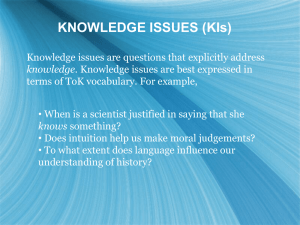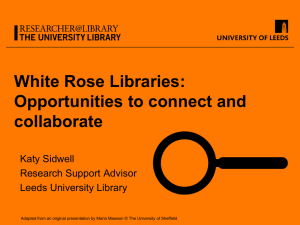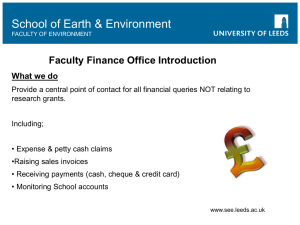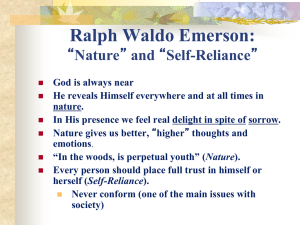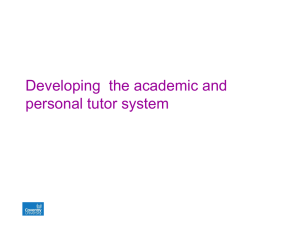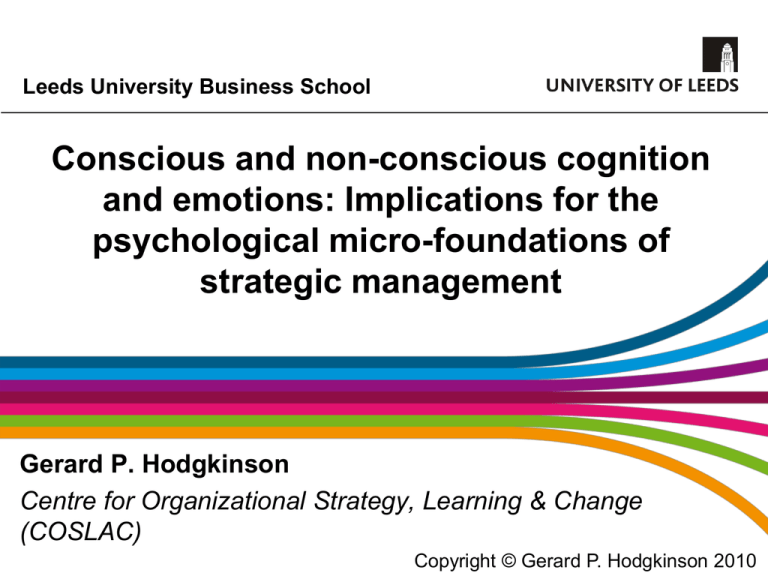
Leeds University Business School
Conscious and non-conscious cognition
and emotions: Implications for the
psychological micro-foundations of
strategic management
Gerard P. Hodgkinson
Centre for Organizational Strategy, Learning & Change
(COSLAC)
Copyright © Gerard P. Hodgkinson 2010
Aims
• Survey recent conceptual and methodological advances
in psychology and related fields that have begun to
provide a deeper understanding of intuition and related
non-conscious, affective-cognitive processes
• Assess the implications of these developments for laying
behaviourally plausible micro-foundations for the field of
strategic management
• In so doing, constructively critique Teece's (2007) recent
dynamic capabilities framework, offering countervailing
psychological insights and prescriptions for
organizational adaptation
Leeds University Business School
Copyright © Gerard P. Hodgkinson 2010
…a timely warning!
• “The hype about neuroscience we’re now seeing has
happened before, with the original left brain/right brain
research, which I helped pioneer. Our work got hugely
distorted in the popular press, and it was impossible to find
hard data for most of the claims that were being made. The
failure to live up to the hype arguably obscured the real
advances we did make...no one gains from a pseudoscientific
approach to business, least of all managers. While I
understand the appeal of bringing scientific rigor to this area
of management, the quest for certainty could well devalue the
intuition that managers traditionally rely on. In the end,
investors pay managers to exercise good judgment, not to
read scanner printouts.” M.S. Gazzaniga, The Brain as
boondoggle, Harvard Business Review March-April, p. 66
(2006)
Leeds University Business School
Copyright © Gerard P. Hodgkinson 2010
The nature of intuition
• Historically viewed as a junk science concept, at best on
the fringes of respectability
• Now occupies important place in dual-process theories of
cognition (both old and new variants), creativity research,
behavioral decision making, personality and individual
differences and social cognitive neuroscience
• Research and practical applications in all the applied
domains of psychology (from industrial/organizational to
educational to medical) and related fields (e.g. law,
management)
Leeds University Business School
Copyright © Gerard P. Hodgkinson 2010
What intuition is not
•
•
•
•
•
•
Instinct
Insight
Tacit knowledge
Creativity
Implicit learning
Implicit memory
Leeds University Business School
Copyright © Gerard P. Hodgkinson 2010
What intuition is not
•
•
•
•
Instinct (basic reflex actions)
Insight
Tacit knowledge
Creativity
Leeds University Business School
Copyright © Gerard P. Hodgkinson 2010
What intuition is not
• Instinct (basic reflex actions)
• Insight (eureka moment preceded by an incubation
period)
• Tacit knowledge
• Creativity
Leeds University Business School
Copyright © Gerard P. Hodgkinson 2010
What intuition is not
• Instinct (basic reflex actions)
• Insight (eureka moment preceded by an incubation
period)
• Tacit knowledge (knowledge that is hard or impossible to
verbalize)
• Creativity
Leeds University Business School
Copyright © Gerard P. Hodgkinson 2010
What intuition is not
• Instinct (basic reflex actions)
• Insight (eureka moment preceded by an incubation
period)
• Tacit knowledge (knowledge that is hard or impossible to
verbalize)
• Creativity (intuition may help the creative process but it’s
not the same thing)
Leeds University Business School
Copyright © Gerard P. Hodgkinson 2010
What intuition is not
•
•
•
•
Instinct
Insight
Tacit knowledge
Creativity
• Yet popular writers and broadcasters frequently confuse
intuition with these related but distinct phenomena
Leeds University Business School
Copyright © Gerard P. Hodgkinson 2010
What intuition is not
•
•
•
•
Instinct
Insight
Tacit knowledge
Creativity
• Yet popular writers and broadcasters frequently confuse
intuition with these related but distinct phenomena
• Or try to blend them in unhelpful ways (e.g. ‘business
instinct’, ‘gut instinct’, ‘intuitive insight’)
Leeds University Business School
Copyright © Gerard P. Hodgkinson 2010
So what is intuition?
• Knowing, without knowing why (Claxton, 2000)
• Accompanied by strong somatic reaction and feeling
of certitude
– Even when taking evasive action, people purporting its use report
a feeling of ‘inner calm’ and certitude
• Typically intuitions occur in situations characterized
by one or more of the following:
–
–
–
–
Time pressure
Information overload
Insufficient information
Acute danger
Leeds University Business School
Copyright © Gerard P. Hodgkinson 2010
Intuiting
(the underlying process of intuition)
• “A complex set of inter-related cognitive, affective and
somatic processes, in which there is no apparent
intrusion of deliberate, rational thought. Moreover, the
outcome of this process (an intuition) can be difficult to
articulate.” (Hodgkinson, Langan-Fox & Sadler-Smith,
2008, p. 4)
Leeds University Business School
Copyright © Gerard P. Hodgkinson 2010
Intuitions defined
• Dane and Pratt (2007: 40) defined intuitions as
‘affectively-charged judgments that arise through rapid,
non-conscious, and holistic associations’
• Three major elements:
– Cognitive
– Affective
– Somatic
Leeds University Business School
Copyright © Gerard P. Hodgkinson 2010
Early ‘Split Brain’
Neuroscience
• Hemispheric specialization, predicated on
the lateralization of function hypothesis
• Informed by Gazanniga and Sperry’s
studies of so-called ‘split brain’ patients
(commissurotomy)
•Strategy
applications:
* Mintzberg (1976)
‘Planning on the left side
and managing on the
right’, HBR
* Taggart & Robey (1981)
‘Minds and Managers’,
AMR
Intuition and conventional dualprocess theory
• Brain is a limited capacity processor of information (cf.
Herbert Simon’s notion of bounded rationality)
• Two forms of processing:
– Automatic (less effortful, non-conscious)
– Controlled (effortful, conscious, analytical)
• Most processing occurs automatically (resource
conservation) and is thus prone to bias
• Views intuition as an automated form of cognition
(summed up by Simon’s notion of ‘analyses frozen into
habit’)
• Hence intuition is a potential source of cognitive bias to be
ironed out via decision-aiding techniques that force a
switch from automatic to controlled, effortful processing
Leeds University Business School
Copyright © Gerard P. Hodgkinson 2010
The nature of intuition: An update
• Conventional dual-process views of intuition are giving
way to conceptions in which skilled decision makers draw
upon conscious and non-conscious cognitive processes in
parallel, which compete and operate in a dynamic
interplay (cf. Evans, 2007, 2008)
• Advances in social cognitive neuroscience (and related
developments in social cognition, cognitive psychology
and neuroeconomics) increasingly support this shift in
emphasis
Leeds University Business School
Copyright © Gerard P. Hodgkinson 2010
Hypothesized neural correlates of the C-system supporting reflective social cognition
(analogous to controlled processing) and the X-system supporting reflexive social
cognition (analogous to automatic processing) displayed on a canonical brain rendering
from (A) lateral, (B) ventral, and (C) medial views.
Note: the basal ganglia and amygdala are subcortical structures that are displayed here
on the cortical surface for ease of presentation. (Source: Lieberman, MD, Annual
Review of Psychology, Vol. 58. © 2007 by Annual Reviews. All Rights Reserved.)
Contemporary Developments in
Social Neuroscience
• Social Cognitive Neuroscience (SCN)
• Integrates social, cognitive, and neurological levels of
analysis, thus avoiding charges of reductionism (Ochsner &
Lieberman 2001)
• This interdisciplinary approach is changing views of a range
of social phenomena, from the formation of political attitudes
(Lieberman et al 2003) to the evolution of culture (Mesoudi et
al 2006)
• Neuroeconomics
• Building on the above developments, this emerging field is
questioning many of the psychological assumptions
embedded in standard economic models
• Attempting to render theories of economic exchange more
consistent with contemporary understanding of the human
brain (Camerer 2005; Glimcher & Rustichini 2004;
Loewestein, 2008; Sanfey et al. 2003)
Leeds University Business School
Copyright © Gerard P. Hodgkinson 2010
Contemporary Developments in
Social Neuroscience
• SCN and Neuroeconomics both posit interaction between two
distinct cognitive systems (each multiple neural)
• Shift from ‘default-interventionist’ to ‘parallel-competitive’ dualprocess models (Evans, 2008)
• Default interventionist dual-process theories posited the role
of cortical/higher mental functions is to correct the ‘primitive’
limbic system’s automatic and affective responses (which are
viewed as sources of bias and irrationality to be minimized)
• Automatic system provides default behaviors (e.g. automatic
attitudes, intuitive judgments) that the analytical system refines
• Parallel-competitive models assume a more complex
interaction between the systems, each operating
simultaneously and competing
• Reflexive processes are not relegated to mere source of
error and bias to be overcome with effort, but integral to
human cognition and critical for skilled processes such as
intuition (Lieberman, 2000)
Leeds University Business School
Copyright © Gerard P. Hodgkinson 2010
Other pertinent developments
• The somatic marker hypothesis
– Memories embodied as resonating emotions activated in
context-congruent situations (Bechara, 2004; Damasio, 1994)
• ‘Affective tags’ (Finucane et al., 2000)
– Positive & negative markers from individuals’ ‘affect pools’ tag to
all mental images (Slovic et al., 2000)
• The affect heuristic and affect as information
• The body loop and as-if loop (Bechara, 2004)
– Decision making under uncertainty with the body loop
– Decision making under certainty with the fainter as-if loop
Leeds University Business School
Copyright © Gerard P. Hodgkinson 2010
Intuitive abilities, styles, and strategies
• Intuition construed as quantifiable differences in task
performance (i.e. ability; cf. Sternberg, 1997)
• Intuition construed as an enduring overarching
preference of approach to information processing (i.e.
cognitive style; cf. Allinson & Hayes, 1996)
• Intuition construed as a cognitive strategy, switchable at
will (cf. Hogarth, 2001; Klein, 2003)
Leeds University Business School
Copyright © Gerard P. Hodgkinson 2010
Basic typology of contrasting cognitive
strategies and styles
Source: G.P. Hodgkinson and I. Clarke, 2007, ‘Exploring the cognitive significance of
organizational strategizing: A dual-process framework and research agenda,’ Human
Relations, 60, 243-255. Copyright © 2007 Sage Publications.
Intuitive ability
• Unresolved issue of accuracy of intuitive judgments
• Intuition may be more useful for generating hypotheses that
need further testing (Atkinson & Claxton, 2000).
• Sources of bias associated with intuitive heuristic judgments
(representativeness, availability and anchoring and
adjustment) well documented in the behavioural decisionmaking literature (e.g. Kahneman, Slovic, & Tversky, 1982).
• However, this lab-based research takes advantage of
participants’ ignorance of arithmetical and statistical principles
rather than focusing on their experience and knowledge and
to require them to generate intuitively a final solution to a
problem (Bowers et al., 1990).
Leeds University Business School
Copyright © Gerard P. Hodgkinson 2010
Rapid Primed Decision Making
– RPD = two-step process (Klein, 1998: 24):
– decision makers ‘size up the situation to recognize which course
of action makes sense’
– evaluate that course of action via mental simulation
Leeds University Business School
Copyright © Gerard P. Hodgkinson 2010
Critique of RPD
(Hodgkinson et al., 2008: pp. 7 - 8)
• High face validity and seemingly corroborated by Klein’s own
empirical findings, but…
• Klein is unclear about the degree of fidelity required of mental
simulations to render them useful in the complex, time
pressured, ‘life-or-death’ situations in which he claims they
are typically deployed
• Given the basic restrictions of working memory capacity,
these simulations must be of limited overall fidelity, but even
allowing for the fact that they are typically constructed on the
basis of just three variables and six transitions, it is difficult to
envisage such simulations being mentally rehearsed in ‘real
time’ in the manner envisaged by Klein
Leeds University Business School
Copyright © Gerard P. Hodgkinson 2010
Measuring intuition as cognitive style
or strategy (ability?)
– Rational-experiential inventory (REI: Epstein et al., 1996)
• Need for cognition (adapted from Cacioppo & Petty,
1982)
• Faith in intuition
– Revised form REI (Epstein et al., 1998)
•
•
•
•
Rational ability (self-report)
Rational engagement
Experiential ability (self-report)
Experiential engagement
– Recent psychometric studies fail to recover the ability-engagement
distinction but strongly support the basic two-dimensional structure
of the original REI (Hodgkinson et al, 2009b), commensurate with
the underlying dual-process theory of Epstein and colleagues
Leeds University Business School
Copyright © Gerard P. Hodgkinson 2010
Future directions in the assessment
of intuition
• The study of intuitive episodes (lab and field) rather
than self-reported preferences
– Use of critical incident technique and repertory
grid/multidimensional scaling to reflect upon incidents where
intuition seems to have been used effectively vs. ineffectively
– Cognitive task analysis/cognitive mapping/knowledge elicitation
procedures in conjunction with time-pressured decision tasks
– Diary studies and related experience sampling methods
– fMRI (in conjunction with the above)
Leeds University Business School
Copyright © Gerard P. Hodgkinson 2010
Can intuition be manipulated?
• $64,000 question
• Need to disentangle the process (intuiting) from the
outcomes (intuitions)
• The short answer is we can probably facilitate the
process but not control the outcomes (but we can
nonetheless assess outcomes, both proximal to and
distal from the decision episode)
• Create the enabling conditions in which skilled intuition is
likely to occur and flourish (see Hodgkinson et al.,
2009a, Long Range Planning)
Leeds University Business School
Copyright © Gerard P. Hodgkinson 2010
Intelligence is…
•
•
•
•
•
•
Clear and conscious
Logical and justified
Error-free and correct
Verbal and symbolic
Egocentric and total
Rapid and decisive
Leeds University Business School
AND
AND
AND
AND
AND
AND
fuzzy/vague
unjustified
experimental
fantasy
empathic
slow / receptive
Copyright © Gerard P. Hodgkinson 2010
Creative cognition
• Creative cognitions manifest as intuitions
(intimations or feelings of knowing) operate at the
other end of the speed continuum to the lighteningfast judgements that arise in response to the
complex, time pressured situations of the type
studied by NDM and expertise researchers
• Allowing for a period of incubation creates space for
mental relaxation and the consequent removal of
analytical blocks, for serendipitous associations to
occur, and allow the slow spreading of activation
trails that may throw up a new metaphor,
perspective or connection that conjoins previously
unrelated elements
Leeds University Business School
Copyright © Gerard P. Hodgkinson 2010
Creative cognition
• The intuitive facet of creativity is both a complex and
ambiguous competency to recognise and assess
• It is also difficult to accommodate within organizational
cultures and structures that scorn fallibility and prohibit
experimentation, risk taking and departures from efficient
standard operating procedures
• The creative cognitions which are one outcome of nonconscious, intuitive processes are, like their analytical
counterparts, fallible, but nonetheless essential to the
generation and exploration of novel ideas in preparing
viable alternatives for success
Leeds University Business School
Copyright © Gerard P. Hodgkinson 2010
Significance for understanding &
developing dynamic capabilities?
• The economic, and to a lesser extent psychological,
microfoundations of dynamic capabilities have received
growing scholarly attention over recent years
• Teece’s (2007) contribution constitutes the most
comprehensive framework to date for the analysis of
capabilities development in organizations
• Teece posited three generic dynamic capabilities as the
core foundations of the evolutionary and economic fitness
of the business enterprise
Leeds University Business School
Copyright © Gerard P. Hodgkinson & Mark P. Healey 2010
SENSING
SEIZING
MANAGING
THREATS/
TRANSFORMING
Analytical
Systems (and
Individual
Capacities) to
Learn and to
Sense, Filter,
Shape, and
Calibrate
Opportunities
Enterprise
Structures,
Procedures,
Designs and
Incentives for
Seizing
Opportunities
Continuous
Alignment and
Realignment of
Specific
Tangible and
Intangible
Assets
DYNAMIC
CAPABILITIES
Foundations of dynamic capabilities & business performance
Adapted from Teece, 2007. ‘Explicating dynamic capabilities: The nature and
microfoundations of (sustainable) enterprise performance.’ Strategic Management
Journal, 28, p. 1342.
Basic Thesis & Contribution
• This framework currently downplays the significance of
emotional/affective and non-conscious cognitive
processes, especially intuition, in sensing, seizing and
reconfiguring
• Accordingly, we revisit the psychological foundations of
Teece’s framework to rectify this imbalance
• We develop countervailing psychological insights on the
origins and development of dynamic capabilities,
highlighting economic actors’ need to blend effortful forms
of analysis with the skilled utilization of less deliberative,
intuitive processes, thereby harnessing the cognitive and
emotional capacities of individuals and groups
Leeds University Business School
Copyright © Gerard P. Hodgkinson & Mark P. Healey 2010
In sum…
• We challenge the key underlying psychological
assumption implicit within Teece’s framework (and the
writings of many contemporary strategic cognition
scholars) that there is a single underlying dimension or
continuum comprising conscious cognition versus nonconscious cognition and emotion/affect
Non-conscious
cognition &
affect/emotion
Leeds University Business School
Conscious
cognition
Copyright © Gerard P. Hodgkinson & Mark P. Healey 2010
Rather…
• some affective and emotional triggers and associated
responses are processed consciously, while others are
processed non-consciously (cf. Bandura, 1986)
Leeds University Business School
Copyright © Gerard P. Hodgkinson & Mark P. Healey 2010
Conscious/deliberative
Subconscious/automatic
‘Hot cognition’
(Emotional/affective)
‘Cold cognition’
Copyright © Gerard P. Hodgkinson & Mark P. Healey 2010
Conscious/deliberative
Subconscious/automatic
‘Hot cognition’
(Emotional/affective)
‘Cold cognition’
Copyright © Gerard P. Hodgkinson & Mark P. Healey 2010
SENSING
SEIZING
MANAGING
THREATS/
TRANSFORMING
Analytical
Systems (and
Individual
Capacities) to
Learn and to
Sense, Filter,
Shape, and
Calibrate
Opportunities
Enterprise
Structures,
Procedures,
Designs and
Incentives for
Seizing
Opportunities
Continuous
Alignment and
Realignment of
Specific
Tangible and
Intangible
Assets
DYNAMIC
CAPABILITIES
Foundations of dynamic capabilities & business performance
Adapted from Teece, 2007. ‘Explicating dynamic capabilities: The nature and
microfoundations of (sustainable) enterprise performance.’ Strategic Management
Journal, 28, p. 1342.
PROBLEM
SEIZING
MANAGING
THREATS/
TRANSFORMING
Enterprise
Structures,
Procedures,
Designs and
Incentives for
Seizing
Opportunities
Continuous
Alignment and
Realignment of
Specific
Tangible and
Intangible
Assets
DYNAMIC
CAPABILITIES
In addition,
learning, sensing,
filtering, shaping &
calibration involve
intuition & other
nonconscious
cognitive
processes and the
use of affective &
emotional
processes
Foundations of dynamic capabilities & business performance
Adapted from Teece, 2007. ‘Explicating dynamic capabilities: The nature and
microfoundations of (sustainable) enterprise performance.’ Strategic Management
Journal, 28, p. 1342.
DYNAMIC
SENSING
as FEELING and
ANALYSIS
SEIZING
MANAGING
THREATS/
TRANSFORMING
Enterprise
Structures,
Procedures,
Designs and
Incentives for
Seizing
Opportunities
Continuous
Alignment and
Realignment of
Specific
Tangible and
Intangible
Assets
CAPABILITIES
Systems and
processes that
enable and support
the blending of
analytical, intuitive
& affective/
emotional
information
Foundations of dynamic capabilities & business performance
Adapted from Teece, 2007. ‘Explicating dynamic capabilities: The nature and
microfoundations of (sustainable) enterprise performance.’ Strategic Management
Journal, 28, p. 1342.
Psychological Foundations of
Sensing Revisited
Extant
Foundations
Supporting
Literature(s)
Supporting
Revised Foundations Literature(s)
Opportunity
discovery and
creation originate
from the cognitive
and creative
(‘right brain’)
capacities of
individuals,
requiring access
to information and
the ability to
recognize, sense,
and shape
developments
Entrepreneurship literature
Identifying and creating Social
opportunities through
cognitive
searching,
neuroscience
synthesizing and
research on
filtering information
the interaction
stems from the
between
interaction between
reflexive and
reflexive (e.g. intuition, reflective
implicit association)
systems (e.g.
and reflective (e.g.
Lieberman,
analogy, explicit
2007)
reasoning) cognitive
and emotional
capabilitiesCopyright © G. P. Hodgkinson & M. P. Healey 2009
Organizational
search
(e.g. March &
Simon, 1958;
Nelson &
Winter, 1982)
Psychological Foundations of
Sensing Revisited (cont.)
Extant
Foundations
Supporting
Literature(s)
Recognizing,
scanning, and
shaping depend
on individuals’
cognitive
capabilities and
extant knowledge
Knowledgebased view of
the firm (e.g.
Grant, 1996)
Revised Foundations
Recognizing, scanning,
and shaping depend on
the capability to harness
emotion to update
mental representations
Organizational (e.g. dissonance
learning (e.g. recognition) and skilled
Levinthal &
utilization of automatic
March, 1993) processes to synthesize
information and form
expert judgments
Supporting
Literature(s)
Cognition and
capabilities
literature (e.g.
Gavetti, 2005)
Affective
processes in
learning (e.g.
Lieberman,
2000)
Copyright © G. P. Hodgkinson & M. P. Healey 2009
Psychological Foundations of
Sensing Revisited - 1
• Affective micro-foundations of sensing
• Utilizing affect as information is an essential part of sensing
• Experts use non-conscious pattern matching, yielding
affectively charged intuitive judgments (Dane & Pratt, 2007;
Lieberman, 2001)
• Emotion directs attention to threats and opportunities
• Affective reactions to opportunities signal need for further
appraisal
• Dissonance provides signal and motivation for schema
change
Leeds University Business School
Copyright © Gerard P. Hodgkinson & Mark P. Healey 2010
Psychological Foundations of
Sensing Revisited - 1
• Implications
• Capabilities in diagnosing/acting on emotional signals, not
suppressing them, differentiate dynamic firms from
unresponsive ones
• ‘Cold’ approaches to schema change insufficient – need
systems, structures and tools to enable emotion learning
(e.g. from dissonance)
• Dynamic capabilities require a psychologically safe climate
Leeds University Business School
Copyright © Gerard P. Hodgkinson & Mark P. Healey 2010
Psychological Foundations of
Sensing Revisited - 2
• Nonconscious micro-foundations of sensing
• Sensing = detailed analysis, deliberative learning (Porter,
1985; Zollo & Winter, 2002)
• But … nonconscious cognition underpins the ability to navigate
the social (e.g. Bargh & Chartrand, 1999) and informational
(Hodgkinson & Sparrow, 2002) environment
• “The inability of the analytical mode to synthesize” (Mintzberg,
1994:320)
• Reflexive processes enable decision makers to cut-through
data to see the ‘big-picture’, vital to strategic situational
awareness (Hodgkinson & Clarke, 2007), which in turn enables
rapid identification of important developments for exploitation
Leeds University Business School
Copyright © Gerard P. Hodgkinson & Mark P. Healey 2010
Psychological Foundations of
Sensing Revisited - 2
• Implications
• Sensing capabilities are not rooted in elaborate
knowledge management systems per se, which can
exacerbate rather than ameliorate information overload
(Griffith, 2008)
Leeds University Business School
Copyright © Gerard P. Hodgkinson & Mark P. Healey 2010
SENSING
SEIZING
MANAGING
THREATS/
TRANSFORMING
Analytical
Systems (and
Individual
Capacities) to
Learn and to
Sense, Filter,
Shape, and
Calibrate
Opportunities
Enterprise
Structures,
Procedures,
Designs and
Incentives for
Seizing
Opportunities
Continuous
Alignment and
Realignment of
Specific
Tangible and
Intangible
Assets
DYNAMIC
CAPABILITIES
Foundations of dynamic capabilities & business performance
Adapted from Teece, 2007. ‘Explicating dynamic capabilities: The nature and
microfoundations of (sustainable) enterprise performance.’ Strategic Management
Journal, 28, p. 1342.
Psychological Foundations of Seizing
Revisited
Extant
Foundations
Supporting
Literature(s)
Revised
Foundations
Supporting
Literature(s)
Seizing innovative
investment choices
requires managers
to override
‘dysfunctions’ of
decision making
Classical
behavioral
decision
theory (e.g.
Kahneman &
Tversky, 1979)
Seizing opportunities
requires harnessing
emotional reactions
to strategic
alternatives
Neuroeconomics:
immediate emotions
shape choice (e.g.
Loewenstein et al.,
2008)
Overcoming biases
requires a
cognitively
sophisticated and
disciplined
approach to
decision making
Classical
behavioral
decision
theory (e.g.
Kahneman &
Tversky, 1979)
Cognitively effortful
processes can
exacerbate bias alleviating bias and
inertia requires
cognitive & emotional
capabilities
Self-regulation (e.g.
Ochsner et al., 2002)
Affect in deescalation of
commitment (e.g.
Sivanathan et al.,
2008)
Copyright © G. P. Hodgkinson & M. P. Healey 2009
Psychological Foundations of
Seizing
• Emotions in strategic decision making
• Visceral (felt) reactions to choice alternatives often
overpower evaluations based on subjective probability
(e.g. Loewenstein et al., 2001; Rottenstreich & Hsee,
2001; Bechara et al., 1997)
• Cold cognitive assessments of new investment
alternatives are unlikely to stimulate effective seizing
• For effective seizing, need to build positive emotional
associations to new opportunities. Highlights the
importance of imagery, scenarios …
Leeds University Business School
Copyright © Gerard P. Hodgkinson & Mark P. Healey 2010
Psychological Foundations of
Seizing (cont.)
• Unlocking fixations with existing strategies
• Escalation of commitment (e.g. Staw, 1976)
• Disengagement from a failing course of action involves
self-regulatory processing to reduce emotional
engagement (Wong et al, 2006; Henderson et al., 2007)
• Hubris may create bias (Hiller & Hambrick 2005; Teece,
2007), but too little self-regard can actually exacerbate
strategic persistence
Leeds University Business School
Copyright © Gerard P. Hodgkinson & Mark P. Healey 2010
SENSING
SEIZING
MANAGING
THREATS/
TRANSFORMING
Analytical
Systems (and
Individual
Capacities) to
Learn and to
Sense, Filter,
Shape, and
Calibrate
Opportunities
Enterprise
Structures,
Procedures,
Designs and
Incentives for
Seizing
Opportunities
Continuous
Alignment and
Realignment
of Specific
Tangible and
Intangible
Assets
DYNAMIC
CAPABILITIES
Foundations of dynamic capabilities & business performance
Adapted from Teece, 2007. ‘Explicating dynamic capabilities: The nature and
microfoundations of (sustainable) enterprise performance.’ Strategic Management
Journal, 28, p. 1342.
Psychological Foundations of
Reconfiguring Revisited
Extant
Foundations
Supporting
Literature(s)
Top management
ability to
coordinate and
execute strategic
renewal and
corporate change
Organizational
structure and
design and
strategy and
performance
literatures (e.g.
Bartlett &
Ghoshal, 1993;
Chandler,
1962)
Revised Foundations
Reconfiguration
requires management
of the transition and
repeated redefinition of
social identities by
alleviating implicit bias
and self-regulating
emotional responses to
identity threats posed
by major change, i.e.
reconfiguration of
social identities with
emotional attunement
Supporting
Literature(s)
Research on
the neural
basis of self
and selfregulation (e.g.
Derks et al.,
2008)
Copyright © G. P. Hodgkinson & M. P. Healey 2009
Psychological Foundations of
Reconfiguring Revisited (cont.)
• Managing social-identity processes is key to reconfiguring
• Identity issues cause resistance to strategic change (e.g. Nag et al.,
2007; Haslam et al., 2003)
• Traditional cognitive solutions (e.g. Gioia et al., 2000) are problematic
• SCN sheds new light on self and identity mechanisms
• Identity threat leads to heightened activity in emotion-regulation
centers of the brain (e.g. Derks et al., 2008)
• Identity threat (e.g. change devaluing a group) and in/outgroup bias
(e.g. against new opportunities, change agents) stems from
automatic social categorization and stereotyping (Amodio, 2008)
Leeds University Business School
Copyright © Gerard P. Hodgkinson & Mark P. Healey 2010
Psychological Foundations of
Reconfiguring Revisited (cont.)
• Implications:
• Reconfiguring involves tackling the emotional and nonconscious (i.e.
reflexive) aspects of identity change
• Self-regulation, affirmation of consonant identities
Leeds University Business School
Copyright © Gerard P. Hodgkinson & Mark P. Healey 2010
Implications and Conclusions
• Toward a ‘behaviorally plausible’ account of dynamic
capabilities? (cf. Gavetti, Levinthal & Ocasio, 2007)
• Extant behavioral theory and research on dynamic capabilities
informed by neo-classical economics divorces cognition from
emotional and affective processes and affords only a minimal role to
nonconscious cognition
• Taken to its logical conclusion, this body of work yields a vision of
organizations starved of emotion and rendered intuitively incapable –
thus, effectively blinkered and relatively unresponsive
Leeds University Business School
Copyright © Gerard P. Hodgkinson & Mark P. Healey 2010
Implications and Conclusions
• Teece’s (2007) framework remains central
• But, behavioral plausibility is not its strength - the core psychological
assumptions underpinning this (and other) framework(s) need revising
in the light of recent advances in social cognitive neuroscience and
neuroeconomics
Leeds University Business School
Copyright © Gerard P. Hodgkinson & Mark P. Healey 2010
Implications and Conclusions
• Learning from contemporary advances in SCN and
neuroeconomics, we offer countervailing descriptive,
normative, and prescriptive insights
• To maximize their true effectiveness in sensing, seizing and
transforming, organizations need to acquire and utilize to the full the
requisite mixture of conscious and nonconscious cognitive processes,
each of which are infused with affectivity and emotion …
… i.e. developing and maintaining dynamic capabilities requires firms
to harness managers’ and employees’ reflexive and reflective abilities
Leeds University Business School
Copyright © Gerard P. Hodgkinson & Mark P. Healey 2010
Where do we go from here?
• We need to continue illuminating the generative
mechanisms that contribute to the identification and
enhancement of intuition and related processes
• In order to develop a more nuanced appreciation as to
when and how their use can be harnessed and
complemented with other approaches
Leeds University Business School
Copyright © Gerard P. Hodgkinson & Mark P. Healey 2010
Some follow up reading
• Hodgkinson, G.P. & Clarke, I. (2007). Exploring the cognitive
significance of organizational strategizing: A dual-process
framework and research agenda. Human Relations, 60, 243-245.
• Hodgkinson, G. P., & Healey, M. P. (2008). Cognition in
organizations. Annual Review of Psychology, 59, 387-417.
• Hodgkinson G. P., Langan-Fox J., & Sadler-Smith E. (2008).
Intuition: A Fundamental Bridging Construct in the Behavioural
Sciences. British Journal of Psychology, 99, 1-27.
• Hodgkinson, G.P., Sadler-Smith, Burke, L.A., Claxton, G., &
Sparrow, P.R. (2009a). Intuition in organizations: Implications for
strategic management. Long Range Planning, 42, 277-297.
• Hodgkinson, G.P., Sadler-Smith, E., Sinclair, M., & Ashkanasy, N.M.
(2009b). More than meets the eye? Intuition and analysis revisited.
Personality and Individual Differences, 47, 342-246.
Leeds University Business School
Leeds University Business School
Conscious and non-conscious cognition and
emotions: Implications for the psychological
micro-foundations of strategic management
Gerard P. Hodgkinson
Centre for Organizational Strategy, Learning and
Change (COSLAC)
Email: g.p.hodgkinson@lubs.leeds.ac.uk
Phone: +44(0)113 343 4468


